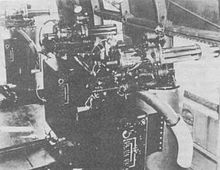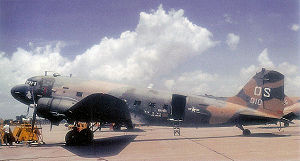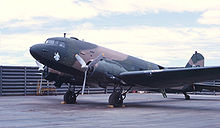- Douglas AC-47 Spooky
-
AC-47 Spooky An AC-47D, 43-49010, on the ground at Udorn Royal Thai Air Force Base, June 1970. A C-47 is displayed at the Air Force Armament Museum marked as this aircraft. Role Fixed-wing gunship Manufacturer Douglas Aircraft Company Introduction 1965 Status In service in Colombia Primary users United States Air Force
Vietnam Air Force
Royal Lao Air Force
Colombian Air ForceNumber built 53 Developed from C-47 Skytrain The Douglas AC-47 Spooky (also nicknamed "Puff, the Magic Dragon") was the first in a series of gunships developed by the United States Air Force during the Vietnam War. It was felt that more firepower than could be provided by light and medium ground-attack aircraft was needed in some situations when ground forces called for close air support.
Contents
Design and development
The AC-47 was a United States Air Force C-47 Skytrain (the military version of the DC-3) that had been modified by mounting three 7.62mm General Electric miniguns to fire through two rear window openings and the side cargo door, all on the left (pilot's) side of the aircraft. Other armament configurations could also be found on similar C-47 based aircraft around the world. The guns were actuated by a control on the pilot's yoke, where he could control the guns either individually or together, though gunners were also among the crew to assist with gun failures and similar issues. Its primary function was close air support for ground troops. It could orbit the target for hours providing suppressing fire. Coverage given by a Spooky was over an elliptical area approximately 52 yd (47.5 m) in diameter, placing a round every 2.4 yd (2.2 m) during a 3-second burst.
The aircraft also carried flares, which it could drop to illuminate the battleground.
The aircraft was vulnerable to ground fire due to the age of its airframe. Further gunship designs, the AC-119 gunship and the AC-130 gunship, were developed based on newer cargo airframes.
When the AC-47 was introduced there were no preceding designs to gauge how successful the concept would be. The USAF found itself in a precarious situation when requests for additional gunships began to come in. It simply did not have enough miniguns to fit additional aircraft after the first two conversions. The next four aircraft were equipped with ten .30 caliber AN/M2 machine guns. It was quickly discovered, however, that these weapons, using ammunition stocks from WWII and Korea, jammed easily, produced large amounts of gases from firing, and, even in ten-gun groups, could only provide the density of fire of a single minigun. All four of these aircraft were retrofitted to the standard armament configuration when additional miniguns arrived.
The AC-47 initially used SUU-11/A gun pods that were installed on locally fabricated mounts for the gunship application. Emerson Electric eventually developed the MXU-470/A to replace the gun pods, which were also used on subsequent gunships.
Operational history
United States Air Force
 AC-47 at Nha Trang Air Base in South Vietnam
AC-47 at Nha Trang Air Base in South Vietnam
In August 1964, years of fixed wing gunship experimentation reached a new peak with Project Tailchaser under the direction of Capt. John C. Simons. This test involved the conversion of a single Convair C-131B to be capable of firing a single GAU-2/A Minigun at a downward angle out of the left side of the aircraft. It was discovered that even using crude grease pencil crosshairs it was very easy for a pilot flying in a pylon turn to hit a stationary area target with relative accuracy. Testing was conducted at Eglin Air Force Base, Florida, by the Armament Development and Test Center (ADTC), but after initial testing was suspended by lack of funding. In 1964 Capt. Ron W. Terry returned from temporary duty in Vietnam as part of an Air Force Systems Command team reviewing all aspects of air operations in counter-insurgency warfare, where he had noted the usefulness of C-47s and C-123s orbiting as flare ships during night attacks on fortified hamlets. He received permission to conduct a live-fire test using the C-131 and revived the side-firing gunship program.
By October, a C-47D was provided by Capt. Terry's team under Project Gunship and converted to a similar standard as the Project Tailchaser aircraft, armed with three Miniguns. These were initially mounted on locally fabricated mounts, which essentially strapped gun pods intended for fixed wing aircraft (SUU-11/A) onto a mount allowing them to be fired remotely out the port side. Captain Terry and a testing team arrived at Bien Hoa Air Base, South Vietnam, on 2 December 1964, with equipment needed to modify two C-47s. The first test aircraft (43-48579, a C-47B-5-DK mail courier converted to C-47D standard by removal of its superchargers) was ready by 11 December, the second by 15 December, and both were allocated to the 1st Air Commando Squadron for combat testing. The newly-dubbed "FC-47" often operated under the radio call sign "Puff". Its primary mission involved protecting villages, hamlets and personnel from mass attacks by VC guerrilla units.
Puff's first significant success occurred on the night of 23-24 December 1964. An FC-47 arrived over the Special Forces outpost at Tranh Yend in the Mekong Delta just 37 minutes after an air support request, fired 4,500 rounds of ammunition, and broke the Viet Cong attack. The FC-47 was then called to support a second outpost at Trung Hung, about 20 miles away. The aircraft again blunted the VC attack, forcing a retreat. Between 15 and 26 December the FC-47s flew 16 combat sorties, all successful. On 8 February 1965, an FC-47 flying over the Bong Son area of Vietnam’s Central Highlands demonstrated its capabilities in the process of blunting a Vietcong offensive. For over four hours, it fired 20,500 rounds into a Viet Cong hilltop position, killing an estimated 300 Vietcong troops.
So successful were the early gunship trials that the second aircraft was returned to the United States early in 1965 to provide crew training. In July 1965, Headquarters USAF ordered TAC to establish an AC-47 squadron. By November 1965, a total of 5 aircraft were operating with the 4th Air Commando Squadron, activated in August as the first operational unit, and by the end of 1965, a total of 26 had been converted. Training Detachment 8, 1st Air Commando Wing, was subsequently established at Forbes AFB, Kansas. In Operation Big Shoot, the 4th ACS in Vietnam grew to 20 AC-47s (16 aircraft plus four reserves for attrition).
The 4th ACS deployed to Tan Son Nhut Air Base, Vietnam, on 14 November 1965. Now using the call sign "Spooky," each of its three 7.62 mm miniguns could selectively fire either 50 or 100 rounds per second. Cruising in an overhead left-hand orbit at 120 knots air speed at an altitude of 3,000 feet, the gunship could put a bullet or glowing red tracer (every fifth round) bullet into every square yard of a football field-sized target in three seconds.[dubious ] And, as long as its 45-flare and 24,000-round basic load of ammunition held out, it could do this intermittently while loitering over the target for hours.
In May 1966, the squadron moved north to Nha Trang Air Base to join the newly-activated 14th Air Commando Wing. The 3rd Air Commando Squadron was activated at Nha Trang on 5 April 1968 as a second AC-47 squadron, with both squadrons redesignated Special Operations Squadrons on 1 August 1968. Flights of both squadrons were stationed at bases throughout South Vietnam, and one flight of the 4th SOS served at Udorn Royal Thai Air Force Base with the 432nd Tactical Reconnaissance Wing. The superb work of the two AC-47 squadrons, each with 16 AC-47s flown by aircrews younger than the aircraft they flew, was undoubtedly a key contributor to the award of the Presidential Unit Citation to the 14th Air Commando Wing in June 1968.
 MXU-470/A Minigun modules in an AC-47.
MXU-470/A Minigun modules in an AC-47.
One of the most publicized battles of the Vietnam War was the siege of Khe Sanh in early 1968, known as "Operation Niagara." More than 24,000 tactical and 2700 B-52 strikes dropped 110,000 tons of ordnance in attacks that averaged over 300 sorties per day. During the two and a half months of combat in that tiny area, fighters were in the air day and night. At night, AC-47 gunships kept up a constant chatter of fire against enemy troops. During darkness, AC-47 gunships provided illumination against enemy troops.
The AC-47D gunship should not be confused with a small number of C-47s which were fitted with electronic equipment in the 1950s. Prior to 1962, these aircraft were designated AC-47D. When a new designation system was adopted in 1962, these became EC-47Ds. The original gunships had been designated FC-47D by the United States Air Force, but with protests from fighter pilots, this designation was changed to AC-47D during 1965. Of the 53 aircraft converted to AC-47 configuration, 41 served in Vietnam and 19 were lost to all causes, 12 in combat.[1] Combat reports indicate that no village or hamlet under Spooky Squadron protection was ever lost, and there are a plethora of reports from civilians and military personnel about AC-47s coming to the rescue and saving their lives.
As the United States began Project Gunship II and Project Gunship III, many of the remaining AC-47Ds were transferred to the Vietnam Air Force (VNAF), the Royal Lao Air Force (RLAF), and to Cambodia, after Prince Sihanouk was deposed in a coup by General Lon Nol.
A1C John L. Levitow, an AC-47 loadmaster with the 3rd SOS, received the Medal of Honor for saving his aircraft, Spooky 71, from destruction on 24 February 1969 during a fire support mission at Long Binh. The plane was struck by an 82mm mortar round that inflicted 3,500 shrapnel holes, wounding Levitow 40 times, but he used his body to jettison an armed magnesium flare, which ignited shortly after Levitow ejected it from the aircraft, allowing the AC-47 to return to base.
Other air forces
Retrofitted AC-47s are still in use in Colombia, where they are known by civilians as Avion fantasma (ghost planes). They are successfully operated by the local airforce in COIN operations in conjunction with AH-60 Arpia helicopters (an armed variant of the UH-60) and A-37 Dragonflys against local illegal armed groups. These are most likely the five BT-67s purchased by Colombia with .50 in (12.7 mm) machine guns (of unknown type) slaved to a Forward Looking Infrared (or FLIR) system.[2] The BT-67 is a variant of the C-47/DC-3 made by the Basler Corporation of Oshkosh, WI. These "Turbo Dakotas" feature Pratt & Whitney Canada PT6A-67R turboprops, driving five-bladed Hartzell propellers, along with essentially overhauling the basic airframe.
In 1970 the Indonesian Air Force converted an ex-civilian C-47. The converted C-47 was armed with three .50 caliber machine guns. During 1975 the Indonesian Air Force used their AC-47 during the Indonesian invasion of East Timor to attack the city of Dili. Later, the AC-47 was used in Indonesian military CAS (Close Air Support) missions in East Timor. Retirement date is unknown.
In late 1984–85, the United States supplied two AC-47 gunships to the El Salvador Air Force (FAS) and trained aircrews to operate the system. The AC-47 gunship carried three .50-caliber machine guns and could loiter and provide heavy firepower for army operations. As the FAS had long operated C-47s, it was easy for the United States to train pilots and crew to operate the aircraft as a weapons platform. By all accounts, the AC-47 soon became probably the most effective weapon in the FAS arsenal.
Variants of the AC-47 based on various iterations of the airframe including the BT-67, have been used by Laos, Cambodia, South Africa, El Salvador and Rhodesia, to name just a few, and with a variety of weapons configurations including Gatling guns of numerous types, various medium and heavy machine guns, and larger autocannon (South African "Dragon Daks" were known to fit 20 mm cannons). ROCAF (Taiwanese Air Force) also converted some of its C-47 to gunships. These machines were armed with M2 machine guns which were likely to be from retired F-86 jet fighters.
Operators
Current Operators
Former Operators
- Indonesian Air Force operated a number of ex-civilian C-47 converted into Gunship
- Rhodesian Air Force operated locally built gunship modification of C-47 aircraft.
Specifications (AC-47)
General characteristics
- Crew: 8: pilot, copilot, navigator, flight engineer, loadmaster, 2 gunners and a South Vietnamese observer
- Length: 64 ft 5 in (19.6 m)
- Wingspan: 95 ft 0 in (28.9 m)
- Height: 16 ft 11 in (5.2 m)
- Wing area: 987 ft² (91.7 m²)
- Empty weight: 18,080 lb (8,200 kg)
- Loaded weight: 33,000 lb (14,900 kg)
- Powerplant: 2 × Pratt & Whitney R-1830 radial engines, 1,200 hp (895 kW) each
Performance
- Maximum speed: 200 kn (230 mph, 375 km/h)
- Cruise speed: 150 kn (175 mph, 280 km/h)
- Range: 1,890 nmi (2,175 mi, 3,500 km)
- Service ceiling: 24,450 ft (7,450 m)
- Rate of climb: ft/min (m/s)
- Wing loading: 33.4 lb/ft² (162.5 kg/m²)
- Power/mass: 0.15 hp/lb (240 W/kg)
Armament
- Guns:
- 3× 7.62 mm General Electric GAU-2/M134 miniguns, 2,000 rpg or
- 10× .30 in Browning AN/M2 machine guns
- 48 × Mk 24 flares
Aircraft on display
- AC-47D Spooky, s/n 43-15510 is on display at the Air Commando Park, Hurlburt Field, Florida.[3]
In popular culture
German Thrash metal band Sodom's 1989 album Agent Orange, revolving largely around Vietnam War themes, features a track named "Magic Dragon". The album's cover art drawing also depicts the gunner of an AC-47 in action.
The development and early deployment of the AC-47 is the subject of The Gooney Bird by William C. Anderson. Anderson went to Vietnam to research this novel, which features a fiction story written around a number of historical facts.
In the film The Green Berets an AC-47 strike enables the American and South Vietnamese forces to retake their firebase, after losing it in an all-night battle.
AC-47 also appears in the first-person shooter Battlefield Vietnam.
See also
- Related development
- Aircraft of comparable role, configuration and era
- Related lists
References
- ^ Hobson, Chris. Vietnam Air Losses, USAF/USN/USMC, Fixed-Wing Aircraft Losses in Southeast Asia 1961-1973. 2001. ISBN 1-85780-1156
- ^ Colombia: Seguridad & Defensa
- ^ "Hurlburt Field"
External links
- USAF museum Douglas AC-47D "Spooky"
- AC-47 at Theaviationzone.com
- AC-47 at Globalsecurity.org
- AC-47 at dc3history.org
- AC-47 at petester.com
Lists relating to aviation General Aircraft (manufacturers) · Aircraft engines (manufacturers) · Airlines (defunct) · Airports · Civil authorities · Museums · Registration prefixes · Rotorcraft (manufacturers) · TimelineMilitary Accidents/incidents Records Categories:- Douglas aircraft
- United States attack aircraft 1960–1969
- Military aircraft of the Vietnam War
- Twin-engined aircraft
Wikimedia Foundation. 2010.


